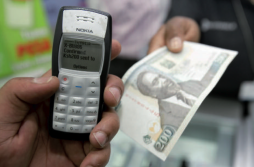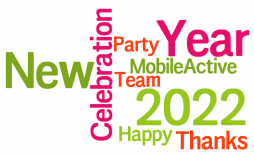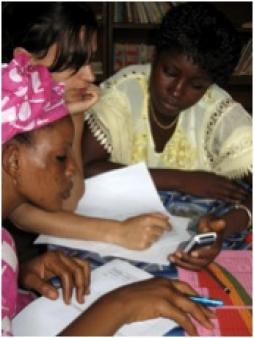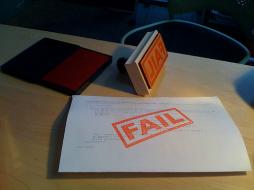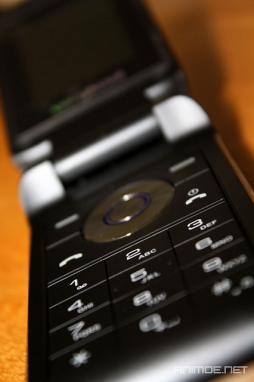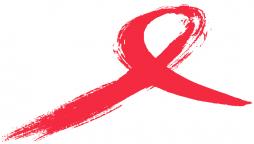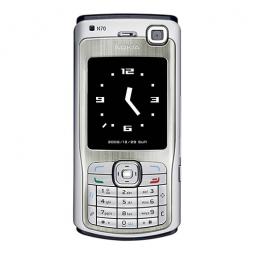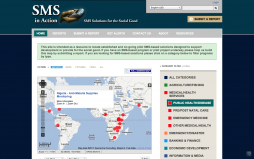Health
Posted by KatrinVerclas on Jun 26, 2008
MobileActive.org wants to hire you! If you are a cracker-jack researcher and writer, we want you for research and stories from around the world about mobiles for social impact. Some data entry on organizations and projects around the world using mobile phones to make the world a better place are also part of the job. Online and telephone research, interviews, writing reports and blog posts.
Must be a thorough researcher, and persuasive and clear writer. Living and working experience in developing country/ies a must. This is an ideal position for journalism graduate student with a great interest in mobile tech, or for a technologist interested in the social implications of the mobile revolution. Location in New York preferred but could be done from anywhere IF it's the right person. Fluency in Spanish or Arabic a great plus. Some travel will be supported.
Send a resume, cover letter explaining why we should hire you, and at least TWO published pieces pertaining to this or a related subject matter of at least 300-500 words. Send your materials to katrin [at] mobileactive [dot] org. Search is open until we find the perfect candidate(s), so hurry.
Posted by on Sep 05, 2007
Reposted from humanitarian.info.
Do mobile phones answer all our prayers? I’ve written about the role that mobile telephony can play in humanitarian assistance quite a few times now, without really talking about it directly. The one line I have consistently taken is that cellphone coverage is not reliable or secure enough to be used as the primary means of communication in an insecure environment.
Putting that to one side for a moment, however, it’s clear that mobile telephony really is the key communications technology for the poor - and that means it should be the key communications technology for the humanitarian community.
Posted by KatrinVerclas on Jan 12, 2007
Following on the heels of the BBC feature on the revolutionary growth and availablity of mobile phones in Kenya, OmyNews features a new project-to-be in South Africa's KwaZulu Natal province. The UmNyango Project of Fahamu, a MobileActive participant, equips rural women in the Province with free text messaging to report on violence against them and their children, and report other abuses. The project coordinator, Anil Naidoo, says: ""This is the first time in KwaZulu Natal that we know of, where SMS technology has been used to directly empower women in this way.
Posted by AnneryanHeatwole on Jan 02, 2012
Welcome to a very mobile 2012! Last year mobiles were at the forefront of protests, citizen journalism, disaster recovery and relief, environmental issues, and more – and brought up questions of security and privacy along the way. Check out our new page dedicated to MobileActive's 2011; the Year in Review pulls together our best content from the year in one easy location.
From the launch of The Mobile Media Toolkit (a great resource for reporters, citizen journalists, and media organizations that want to use mobile technology in their work) and our increased focus on security and privacy with the SaferMobile initiative, we've set the groundwork for big changes in 2012.
Keep in contact with MobileActive through Twitter, Facebook, our discuss list, or our newsletters at MobileActive.org and (for all of you reporters and citizen journalists) at the Mobile Media Toolkit. We hope that everyone has a safe and happy New Year, and we are excited for what 2012 holds. Thanks for being part of the MobileActive community!
Posted by EKStallings on Dec 20, 2011
Design and Usability Testing of an mHealth Application for Midwives in Rural Ghana data sheet 674 Views
Abstract:
Midwives in Ghana provide the majority of rural primary and maternal healthcare services, but have limited access to data for decision making and knowledge work. Few mobile health (mHealth) applications have been designed for midwives. The study's purpose was to design and test an mHealth application (mClinic) that can improve data access and reduce the reporting burden for midwives at the Millennium Villages Project site in Ghana.
From the design science field, the Information Systems Research Framework guided this study through two research cycles: 1) Relevance, and 2) Design. The first phase of the Relevance Cycle took a user-centered approach to assess the people, organizations, and technology of the midwives’ environment through participant observation, contextual inquiry, and interviews. In the second phase, structured requirements specification was used to categorize the data into goals, system qualities, and constraints. From the categorized data, use cases were developed for patient registration, antenatal care, malaria, family planning, and referrals. Use cases then informed the development of functional requirements. In the Design Cycle, we first used functional requirements for patient registration and malaria to develop the mClinic prototype as part of a coded-in-country initiative. Next, we examined usability of the mClinic prototype by conducting field testing, heuristic evaluation, and usability surveys. Additionally, low-fidelity prototyping was used to determine applicability of the other use cases to the midwives’ environment.
Midwives reported inability to access critical data, high patient loads, and extensive reporting requirements. Low technical self-efficacy and inadequate infrastructure were identified as barriers to implementation. Heuristic evaluation noted issues related to hardware selection, workflow, and security. Midwives ranked the tool as useful in the usability survey; however, ease-of-use rankings were neutral. Interviews indicated this was related to low technical self-efficacy. Applicability checks found support for touch-entry prototypes over those that included lengthy forms or text-entry.
Posted by AnneryanHeatwole on Dec 19, 2011
Mali has one of the highest infant mortality rates in the world. There are roughly 111 deaths for every 1000 live births in the country and the under-5 mortality rate is 191 out of every 1000 children. The need for early detection of diseases and stronger local health structures led to the creation of Pesinet, a non-profit that uses mobile technology to provide regular health checkups and affordable health insurance for young children in Mali's capital, Bamako.
Roughly 600 children are currently enrolled in the program in the neighborhood of Bamako Coura, under the care of four Pesinet agents (each covering around 150 children). Pesinet combines both early warning systems and insurance. Families pay 500 CF a month for each enrolled child; the payments cover doctor examinations and half the cost of any medications the child needs if he or she gets sick.
Enrolled children are tested weekly for symptoms of illness such as fever, cough, diarrhea, low weight, or vomiting by community health workers who enter data from each visit into a custom-designed Java application on their phone. The data is sent via GPRS to an online database. Doctors at local community health centers monitor the patient data for sudden changes in health. If changes occur, the community health workers receive an alert on their phones and then go back, in turn, to alert the family that the doctor needs to give the child a checkup.
| Pesinet: Mobile Monitoring and Micro-Insurance for Children in Mali data sheet 1280 Views |
| Countries: |
Mali
|
Posted by AnneryanHeatwole on Dec 16, 2011
FailFaire – where it's okay to admit the mistakes. MobileActive hosted another round of FailFaire, bringing together practitioners, developers, donors, and students involved in the use of technology for social change development to discuss what's usually swept under the rug – project failure. The event is an open space to discuss those projects that went wrong in our field fostering a sense of learning from mistakes and knowledge sharing. The latest FailFaire in New York brought together eight practitioners to present their failed projects and what they learned along the way. Take a look at this FastCompany article about the NYC FailFaire for some background.
So, here we bring you...
Posted by EKStallings on Dec 16, 2011
mHealth: New Horizons for Health Through Mobile Technologies data sheet 487 Views
Author:
Mechael, Patricia, Nadi Kaonga, and Hima Batavia, Lilia Perez-Chavolla
Abstract:
For the first time the World Health Organization’s (WHO) Global Observatory for eHealth (GOe) has sought to determine the status of mHealth in Member States; its 2009 global survey contained a section specifically devoted to mHealth. Completed by 114 Member States, the survey documented for analysis four aspects of mHealth: adoption of initiatives, types of initiatives, status of evaluation, and barriers to implementation. Fourteen categories of mHealth services were surveyed: health call centres, emergency toll-free telephone services, managing emergencies and disasters, mobile telemedicine, appointment reminders, community mobilization and health promotion, treatment compliance, mobile patient records, information access, patient monitoring, health surveys and data collection, surveillance, health awareness raising, and decision support systems.
The survey shows there is a groundswell of activity. The majority of Member States (83%) reported offering at least one type of mHealth service. However, many countries offered four to six programmes. The four most frequently reported mHealth initiatives were: health call centres (59%), emergency toll-free telephone services (55%), managing emergencies and disasters (54%), and mobile telemedicine (49%). With the exception of health call centres, emergency toll-free telephone services, and managing emergencies and disasters, approximately two thirds of mHealth programmes are in the pilot or informal stage.
The survey results highlight that the dominant form of mHealth today is characterized by small-scale pilot projects that address single issues in information sharing and access. There were only limited larger mHealth implementations (primarily supported by public-private partnerships). While it is anticipated that large-scale and complex programmes will become more common as mHealth matures, strategies and policies that integrate eHealth and mHealth interoperability into health services would be wise. mHealth is no different from other areas of eHealth in its need to adopt globally accepted standards and interoperable technologies, ideally using open architecture. The use of standardized information and communication technologies would enhance efficiency and reduce cost. To accomplish this, countries will need to collaborate in developing global best practices so that data can move more effectively between systems and applications.
Posted by AnneryanHeatwole on Dec 12, 2011
Scaling Up Mobile Health: Elements Necessary for the Successful Scale Up of mHealth in Developing Countries data sheet 565 Views
Abstract:
The use of mobile phones to improve the quality of care and enhance efficiency of service delivery within healthcare systems is known as mobile health, or mHealth, and is a sub-segment of the broader field of electronic health (eHealth). WHO has defined mHealth as the “provision of health services and information via mobile technologies such as mobile phones and Personal Digital Assistants (PDAs).” mHealth tools have shown promise in providing greater access to healthcare to populations in developing countries, as well as creating cost efficiencies and improving the capacity of health systems to provide quality healthcare.
Recent evidence from randomized scientific trials and studies has demonstrated that the capabilities of mobile phone technology, particularly SMS messaging, can positively impact treatment outcomes. Results of the WelTel Kenya1 clinical trial, the first study of its kind in Africa, were published in The Lancet in November of 2010. The trial focused on the impact of SMS messaging on HIV-infected adults starting antiretroviral therapy (ART) in three clinics in Kenya. The study showed that patients who received SMS support had significantly higher adherence to ART and higher rates of viral suppression when compared with patients in the control group. A scale up of such a mobile phone support system in Kenya could suppress viral loads in 26,000 extra people at the cost of less than USD 8 per person per year, according to Richard Lester of the British Columbia Centre for Disease Control and the study’s lead researcher. Another cluster-randomized trial at 107 rural facilities in Kenya found that SMS message reminders sent to health workers’ mobile phones improved and maintained their adherence to treatment guidelines for outpatient pediatric malaria in Kenya.
A multitude of mHealth solutions have emerged over the years in countries such as Ethiopia, Kenya, Nigeria and South Africa, which are leading the way in using mobile health services, according to the Global Observatory for eHealth at the WHO. Getachew Sahlu of the WHO identified the convergence of the following factors as the driving force behind the current rapid mHealth growth in developing countries: (1) a record growth of mobile phone users, (2) rapid expansion of mobile networks, (3) the decline in mobile phone costs, and (4) the innovation in mobile technology. The mobile platform presents the unique capability of delivering healthcare services wherever people are—not just in healthcare facilities. mHealth initiatives have also been effective in reaching underserved populations, particularly those in rural areas, changing health behaviors and outcomes, and addressing a wide variety of healthcare challenges, including:
• The shortage of skilled healthcare workers in certain developing country settings
• Treatment adherence and compliance
• Lack of timely and actionable disease surveillance
• Poor drug inventory and supply chain management
• Use of counterfeit drugs
• Lack of medical diagnostic treatment
• Slow rates of information flow and reporting delays.
mHealth represents a cost-effective technology solution to many of these challenges if implemented correctly and brought to scale. The costs of mobile handsets and usage are declining as demand for mobile services increases and mobile networks are being rapidly expanded.
Posted by AnneryanHeatwole on Dec 09, 2011
We recently attended the mHealth Summit 2011 to learn more about the latest developments in the mobile health field. The conference brought together developers, practitioners, NGOs, representatives from corporate industries, and government officials to discuss the current state and future of mobile health.
Several key trends emerged among the discussions, focusing on: local buy-in and capacity building, the importance of building partnerships and trust among communities, and the need to transition from short-term pilots to scalable, sustainable mHealth projects.
Scale, Sustainability, and Hype
There was a lot of discussion at the mHealth Summit 2011 about the number of failed pilot projects and the hype around mobile health. More productively, there was considerable discussion on what steps can be taken to reduce the waste (including financial, time, and community good-will) that results from launching unusable, unscalable, or unsustainable mobile health projects. The honest assessment of challenges in the m-health field led to discussions about scalability and sustainability.
Posted by AnneryanHeatwole on Dec 02, 2011
It may be the end of the year, but that doesn't mean mobile events are slowing down! With conferences, calls for research, developer meet-ups, and networking opportunities, you won't get bored this December. Check out what's happening with mobiles this month:
- 5 December, Mobile Monday Las Vegas (Las Vegas, USA) The inaugural Las Vegas Mobile Monday meeting will feature presentations of mobile applications, product demonstrations, and discussions about social media outreach and investing.
- 5-7 December, mHealth Summit (Washington, D.C., USA) The third year of the mHealth Summit looks at how multiple sectors (including governments, NGOs, the telecommunications industry, and academia) can work together to create mobile health projects that improve health systems around the world. We'll be reporting from there.
- 6 December, The Guardian Mobile Business Summit 2011 (London, UK) This event focuses on the business side of mobile use – branding, user engagement, content creation and delivery, and mobile advertising. The event also has a large focus on networking for attendees.
- 6-9 December, MobiQuitous 2011 (Copenhagen, Denmark) For researchers and practitioners in the mobile and computing worlds, MobiQuitous offers a chance to share research and learn from workshops and discussions.
Posted by EKStallings on Dec 01, 2011
MobileActive.org recognizes World AIDS Day today, December 1, by featuring some of the organizations and programs that utilize mobile tech in the fight against HIV/AIDS. We hope that countries around the world will continue to fulfill their funding commitments in the fight against AIDS.
Designing SMS Reminders for HIV/AIDS Patients in Peru
SMS reminders are a key component of many mHealth programs targeting drug compliance among HIV/AIDS patients. This slidecast features the findings of Dr. Curioso and colleagues from their research in Peru. The slides address patient recommendations for SMS content and tone, program development, and concerns for cultural appropriateness.
Impact of a mHealth Intervention for Peer Health Workers on AIDS Care in Rural Uganda
This study came our way through a member, Larry W. Chang. Chang et al. evaluated the impact of a mHealth intervention for peer health workers providing AIDS care in Uganda. While the group found no significant difference in health between the study and controls groups, the peer health workers and patients involved showed broad support for the initiative, and improvements in patient care were found.
Text to Change
In our World AIDS Day roundup last year we covered a Kenyan pilot of Text to Change, an SMS-based quiz of HIV/AIDS knowledge. This year we got to learn about two deployments of Text to Change in Uganda.
Posted by VivianOnano on Nov 21, 2011
User Guide | Data Integrity data sheet 707 Views
Abstract:
FrontlineSMS is a software platform that enables structured communication via text messaging, using only a computer and a mobile phone or GSM (Global System for Mobile) modem. The platform enables two-way messaging between users and groups of people via mobile networks without the need for an Internet connection.
The purpose of this guide is to provide FrontlineSMS users designing, implementing, and monitoring programs with data integrity concerns in mind with a data integrity framework. The guide is intended to help users to understand, analyze, and address the vulnerabilities, risks and threats that can affect the integrity of the information communicated through the FrontlineSMS platform.
Posted by EKStallings on Nov 11, 2011
Health Information as Health Care: The Role of Mobiles in Unlocking Health Data and Wellness data sheet 864 Views
Abstract:
Around the world, countless lives are lost due to insufficient access to quality health information. The availability of accurate, timely, and analyzed data is directly relevant to the quality of an individual’s health and the healthcare system in general, the delivery of individual care, and the understanding and management of overall health systems.
This discussion paper:
1) Examines the role ICTs, and mobile technology in particular, can play in improving access to quality health information, review the ecosystem of health information related to patients,
2) Traces the data throughout the continuum of care, examine health information flows from patients in villages to international health organizations and the most important steps in between,
3) Identifies common ground on which technologists and public health professionals can develop innovative strategies and tools to strengthen health care systems by supporting health data flows, working from the premise that better data collection will lead to better health policies and health outcomes,
4) Focuses on three healthcare domains – surveillance systems, supply chain, and human resources – and through the perspectives of experts in these domains, identify critical gaps in health information flows that technology-based solutions could address. In the case of each of these three domains, we use maternal health as an example to show how technology-backed interventions can improve health information flows,
5) Identifies barriers, choke points, and other inefficiencies to guide the discussion of how modern ICTs can improve health information flows and health outcomes in the developing world,
6) Provides recommendations for using modern ICTs to make health information flow more efficiently and perhaps even transform the process of care delivery itself.
Posted by EKStallings on Nov 08, 2011
Evaluating mHealth Adoption Barriers: Human Behavior data sheet 744 Views
Author:
Jones, Tim, Stephen Johnston, Fonny Schenck, Juliet Bedford,
Abstract:
The Vodafone Health Debate series is part of our continuing commitment to thought leadership in healthcare. It brings together senior pharma, public and private health stakeholders to learn, share and debate on issues and new thinking brought forward by renowned thought leaders and industry experts. Our aim is to provide some evidence- based stimulus that will encourage all those working in the different areas of healthcare to consider the innovation opportunities that are now available to them.
We believe that real progress can only be initiated when all stakeholders look beyond traditional horizons and share ideas that challenge the status quo so that together we can identify new ways of addressing current issues. Regulatory complexity, financial constraints, entrenched infrastructures and poor investment in technology combined with a lack of understanding by technology providers has meant that digital innovation in healthcare has been slow to take hold.
However, given changing healthcare needs of an increasingly aging population and the challenges presented by the current economic crisis, there is renewed interest in the potential of mHealth and Internet solutions to help reduce costs, increase efficiencies and effectiveness. This paper explores the practical reasons behind the slower than expected adoption of digital health technologies and discusses experiences from other sectors that could potentially help create wide scale adoption.
Posted by EKStallings on Nov 04, 2011
A Doctor in Your Pocket: Health Hotlines in Developing Countries data sheet 1094 Views
Author:
Ivatury, Gautam, Jesse Moore, Alison Bloch
Abstract:
The GSM Association—the global trade association for mobile network operators—and its Development Fund believe that health hotlines can transform healthcare for poor people just as mobile phones are revolutionizing financial services (‘mobile money’). Health hotlines are simple to understand (“call a doctor”), provide immediate assistance, and are available to anyone with a mobile phone. The reach and branding of a mobile network operator (MNO), and the scalability of call center technology may mean that health hotlines serve vast numbers of people in the coming years.
As a first scan of the approach, this report tracks hotlines operating in developing countries, assesses their social and commercial success to date, and offers suggestions for governments, industry bodies and development agencies to advance this approach.
In the first section we define the health hotline model and present a brief landscape of health hotlines in operation today. Section 3 spotlights four of the most prominent health hotlines in developing countries, and compares their business approaches. In Section 4 we assess their commercial viability and potential for growth, and in Section 5 we evaluate their potential for social impact. Finally, Section 6 offers thoughts on how development agencies and governments can support the health hotline phenomenon.
Posted by EKStallings on Nov 04, 2011
Cell-Life, Case Study 11 data sheet 991 Views
Author:
Willmers, Michelle, Cheryl Hodgkinson-Williams
Abstract:
This case study analyses the ways in which the Cell-Life initiative, a collaboration between UCT‘s (University of Cape Town) departments of Civil and Electrical Engineering and the Cape Peninsula University of Technology (CPUT), utilises technology-based solutions (in particular, cellphone technology) for the life management of patients living with HIV/AIDS.
Cell-Life is a model example of a socially responsive endeavor which utilizes technology to overcome limitations and constraints. The use of cellphones to save lives by aiding adherence to the ARV medication regime and gather data is a remarkable contribution to the fight against the HIV/AIDS pandemic and signifies an intersection between the academic endeavour, innovation and the lives of ordinary people on the ground. The open approach taken by the organisation in sharing its work also illustrates how research is able to contribute to the 'undead count' (i.e. the number of lives saved) of academic research, which must surely be considered the greatest achievement of any endeavor.
Posted by EKStallings on Nov 02, 2011
Case Study for Incorporation of Mobile Technology in Maternal, Neonatal and Child Health (Manoshi) Program at BRAC Health data sheet 862 Views
Abstract:
After extensive studies of BRAC’s health services for mothers, neonates and children in rural and urban areas (MNCH and Manoshi, respectively), ClickDiagnostics has developed a mobile phone-based solution for streamlining BRAC’s data collection procedures in Manoshi, enabling BRAC to take a more pro-active approach in strategizing and reaching the women most in need in the urban slums.
ClickDiagnostics is in the concluding stages of piloting thissolution jointly with BRAC, and after the completion of the project in January, will support BRAC in refining the model and scaling up for nationwide implementation in MNCH and Manoshi projects, and possibly also in BRAC Health’s other program.
One important reason why many pregnant mothers succumb to death or preventable miscarriages is that it is expensive for government or non-government health organizations to track pregnant mothers to assess their level of risk and prioritize its limited resources for targeted intervention. A model in which community health-workers use ICT to gather real-time information about pregnant women and send to a specialist can help to address this gap and help health organizations take precautionary measures about risky cases of pregnancies.
Posted by EKStallings on Nov 01, 2011
Improving Standards of Care with Mobile Applications in Tanzania data sheet 965 Views
Author:
Bogan, Molly, Jan van Esch, Gayo Mhila, Brian DeRenzi, Caroline Mushi, Timothy Wakabi, Neal Lesh, Marc Mitchell
Abstract:
In this paper, we present D-tree International’s work with medical algorithms and mobile applications to improve the standards of care in clinical and community settings. In particular, we present a mobile phone-based application called CommCare which helps community health workers (CHWs) to provide home-based care and social support to HIV, tuberculosis and other chronic patients. The application guides the CHWs through a series of questions which they answer using the phone’s number pad. The data then can be submitted directly to a central database over a cellular GPRS network.
We report on our experience developing and testing the application in Tanzania, including the iterative development process with the CHWs and training them to use the program. We include an account of some of the hardware and software issues encountered and resolved during the process, and some initial reactions from the first CHWs and clients to use the program. While the formal evaluation of the program is still in progress, initial findings show that the phonebased system is generally viewed positively by the users and by the clients as more discreet and better for privacy than the paper-based system.
Posted by AnneryanHeatwole on Nov 01, 2011
Making health initiatives more accessible through technology can help patients and doctors keep themselves better informed about health and wellness. On October 25th, The Path of the Blue Eye hosted unNiched: Scratch, Sniff and Learn, a short conference focusing on innovation in the health marketing and communications world. Fard Johnmar, one of the founders of the Path of the Blue Eye project, introduced all the speakers and explained that the event is about " really getting people together from different disciplines, so that they can learn from each other and improve health and wellness."
Seven organizations gave short presentations on their health and technology initiatives before the group broke out into smaller discussions and demonstrations. Three of the projects presented at unNiched with a mobile focus: MoTeCh, a program using mobile phones to connect community health workers and beneficiaries in Uganda; Ubiqi, a mobile tracking tool for patients with chronic disease; and InStrat, a personalized SMS health alert system. While introducing the mobile technology section of unNiched Johnmar said, "So mobile – you'll see in today's presentations and by interacting with our innovators – really means empowerment, education and finally, most important for me, behavior change." Watch a short video featuring excerpts from the mobile UnNiched presentations below to see how the organizations are using mobile in their work, and read on for a description of each project.
Posted by EKStallings on Oct 19, 2011
Despite possibilities of scaling projects with technology, many technology-based initiatives in social and economic development have failed to make it past early pilot stages or grow to scale. This study by Hystra, in collaboration with Ashoka and TNO, examines what successful ventures within four sectors can teach us about models for scaling Information and Communications Technology (ICT) -based applications and projects aimed at reaching bottom-of-the-pyramid customers (referred to as Base of the Pyramid in the report). The researchers focused specifically on these sectors: education, health, agricultural services, and financial services.
What Did the Study Review?
Initially considering 280 projects as promising models, researchers found that over half were not worth researching because projects lacked sustainability or replicatibility. Many of the projects were dead pilot projects or were small with no sign of the possibility or intent of scaling in size or reach.
From there, researchers homed in on 16 groundbreaking cases. These projects had reached scale (defined as having 10,000 clients or more) or had the potential to do so. All projects were assessed against three criteria: Is the solution solving the (specified) problem? Is the project economically viable? Is the project scalable and replicable? The researchers grouped projects into specific clusters based on business model type. All projects researched were value-added or market-based, because of the researchers’ belief that such models increase project sustainability and client investment in the project.
The models that the researchers looked at varied. For instance, researchers asked whether end-users accessed the technology themselves as opposed to being delivered trough an intermediary.
Posted by AnneryanHeatwole on Oct 13, 2011
Today's Mobile Minute brings you news about the decline of knock-off phones in China, mobile phone statistics in South Africa, the case for password protecting your mobile phone, challenges to mHealth projects in Africa, and new global mobile statistics.
- A new article from the L.A. Times looks at the fall in popularity of shanzhai (knock-off) phones in China, as shanzhai phones now represent only 7% of the Chinese market, down from 20% in 2007. The article says that the trend for buying brand-name phones is due to the greater availability of low-cost smartphones, and a preference for high-end features in smartphones that the knock-offs can not replicate.
- Nielsen Wire recently released a study on mobile use in South Africa, examining everything from network loyalty and social mobile use (such as downloading ringtones, wallpapers, and screensavers), to comparisons between mobile contracts and pre-paid phones and the use of SMS and mobile instant messaging services.
- Do you password protect your phone? Read Write Web reports that more than half of smartphone owners surveyed by Confident Technologies do not lock and password protect their phones. If your phone is stolen, lost, or confiscated then all of your personal data (including contacts in the address book, emails saved in your inbox, and log-ins for social media sites like Twitter and Facebook) stored on your phone could be compromised; using a password makes this information harder to access.
- PBS examines the hype around mHealth projects in the developing world, and whether mobile technologies are successful at managing health issues. The article looks at challenges to mHealth projects such as limited mobile access for beneficiaries, spotty network coverage, the high costs of large-scale projects, and the difficulty of maintaining charged phones.
Posted by ccarlon on Oct 04, 2011
An Exploratory Study on the Use of Camera Phones and Pico Projectors in Rural India data sheet 1974 Views
Author:
Mathur, Akhil, Divya Ramachandran, Edward Cutrell, and Ravin Balakrishnan.
Abstract:
We explore the potential of using camera phones and pico projectors in rapid creation and presentation of digital content in a development context. A camera phone based content authoring application was designed and deployed with three different user populations in the domains of classroom education and health care.
Our findings show that despite the variations in education levels, cultural background, and technology exposure, users successfully created and presented different forms of digital content using the camera phone and pico projector.
Posted by VivianOnano on Sep 30, 2011
The Effectiveness of M-Health Technologies for Improving Health and Health Services: A Systematic Review Protocol data sheet 1621 Views
Author:
Free,Caroline; Gemma Phillips; Lambert Felix; Leandro Galli; Vikram Patel; Philip Edwards.
Abstract:
The application of mobile computing and communication technology is rapidly expanding in the fields of health care and public health. This systematic review will summarise the evidence for the effectiveness of mobile technology interventions for improving health and health service outcomes (M-Health) around the world.
To be included in the review interventions must aim to improve or promote health or health service use and quality, employing any mobile computing and communication technology. This includes:
(1) interventions designed to improve diagnosis, investigation, treatment, monitoring and management of disease;
(2) interventions to deliver treatment or disease management programmes to patients, health promotion interventions, andinterventions designed to improve treatment compliance; and
(3) interventions to improve health care processes e.g. appointment attendance, result notification, vaccination reminders.
A comprehensive, electronic search strategy will be used to identify controlled studies, published since 1990, and indexed in MEDLINE, EMBASE, PsycINFO, Global Health, Web of Science, the Cochrane Library, or the UK NHSHealth Technology Assessment database. The search strategy will include terms (and synonyms) for the following mobile electronic devices (MEDs) and a range of compatible media: mobile phone; personal digital assistant (PDA); handheld computer (e.g. tablet PC); PDA phone (e.g. BlackBerry, Palm Pilot); Smartphone; enterprise digital assistant; portable media player (i.e. MP3 or MP4 player); handheld video game console. No terms for health or health service outcomes will be included, to ensure that all applications of mobile technology in public health and healthservices are identified.
Bibliographies of primary studies and review articles meeting the inclusion criteria will besearched manually to identify further eligible studies. Data on objective and self-reported outcomes and study quality will be independently extracted by two review authors. Where there are sufficient numbers of similar interventions, we will calculate and report pooled risk ratios or standardised mean differences using meta-analysis.
This systematic review will provide recommendations on the use of mobile computing and communication technology in health care and public health and will guide future work on intervention development and primary research in this field.
Posted by ccarlon on Sep 30, 2011
SMS in Action is an interactive crowdmap that allows users to submit and search for SMS-based systems that aim (or claim) to have a social impact. The map can be filtered by categories including Agriculture, Health, Emergency/Disaster Services, Banking, Economic Development, Information and Media, Education, and Governance with many of these categories dividing into further subcategories. Reports may also be filtered by report date.
Corresponding markers on the map can be clicked giving the user the option to zoom in/out or get more information. While clearly still in its early stages, the map has a lot to offer. A quick search for disease programs under medical/health returned over a dozen hits across the map. Additionally, users may subscribe to receive location-specific email alerts whenever a report is posted within 20 miles of a designated area.
